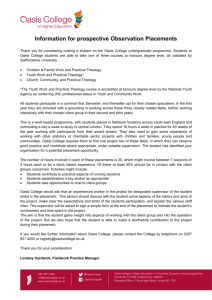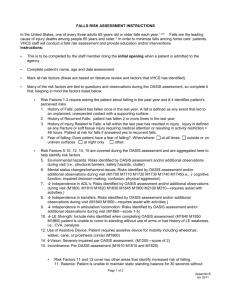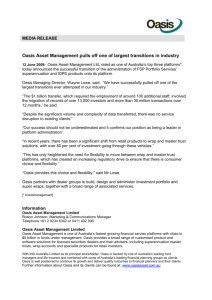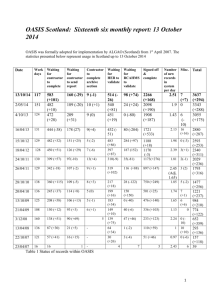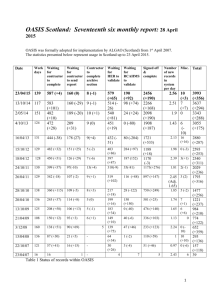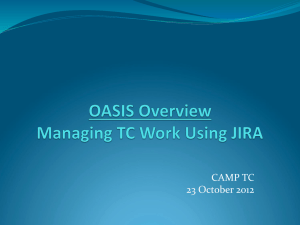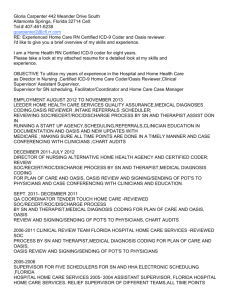OASIS Scotland: Six monthly report 20th April 2010
advertisement
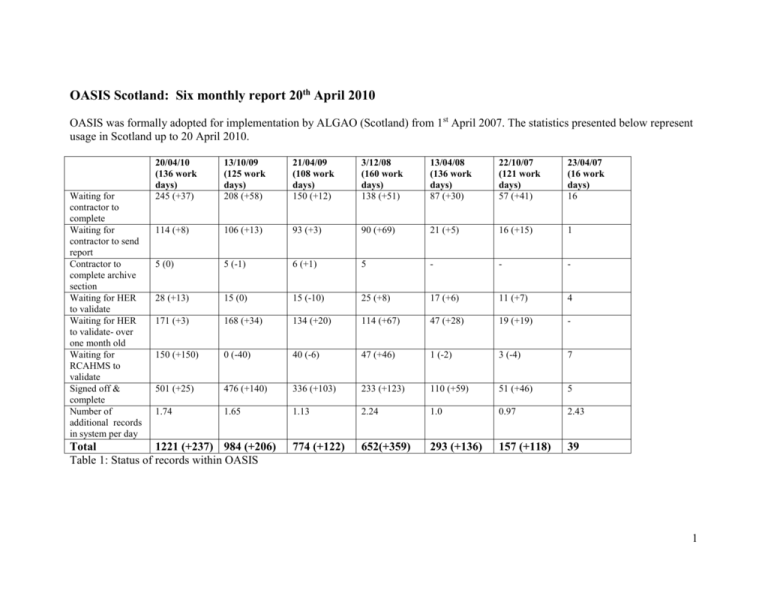
OASIS Scotland: Six monthly report 20th April 2010 OASIS was formally adopted for implementation by ALGAO (Scotland) from 1st April 2007. The statistics presented below represent usage in Scotland up to 20 April 2010. Waiting for contractor to complete Waiting for contractor to send report Contractor to complete archive section Waiting for HER to validate Waiting for HER to validate- over one month old Waiting for RCAHMS to validate Signed off & complete Number of additional records in system per day 20/04/10 (136 work days) 245 (+37) 13/10/09 (125 work days) 208 (+58) 21/04/09 (108 work days) 150 (+12) 3/12/08 (160 work days) 138 (+51) 13/04/08 (136 work days) 87 (+30) 22/10/07 (121 work days) 57 (+41) 23/04/07 (16 work days) 16 114 (+8) 106 (+13) 93 (+3) 90 (+69) 21 (+5) 16 (+15) 1 5 (0) 5 (-1) 6 (+1) 5 - - - 28 (+13) 15 (0) 15 (-10) 25 (+8) 17 (+6) 11 (+7) 4 171 (+3) 168 (+34) 134 (+20) 114 (+67) 47 (+28) 19 (+19) - 150 (+150) 0 (-40) 40 (-6) 47 (+46) 1 (-2) 3 (-4) 7 501 (+25) 476 (+140) 336 (+103) 233 (+123) 110 (+59) 51 (+46) 5 1.74 1.65 1.13 2.24 1.0 0.97 2.43 774 (+122) 652(+359) 293 (+136) 157 (+118) 39 Total 1221 (+237) 984 (+206) Table 1: Status of records within OASIS 1 Figure 1: increase in number of records in OASIS for Scotland since launch (based on information reported at Management Board) There has been steady use of OASIS over the last six months (figure 1) with 1221 project records submitted through the application for Scotland. A further 237 records have been added since the last Management Board in October 2009. Adjusting the figures to take account of the uneven reporting period shows a slight increase in the number of records added per day over the last six months compared to most of the previous reporting cycles (figure 2). Figure 2: number of records added to OASIS per workday (x10 exaggeration) based on figures reported to Management Board 2 Status of OASIS records in Scotland Figure 3: trends in record status over last four reporting cycles, November 2008 to April 2010. Over the last four reporting periods, the percentage split between records added by the contractor, waiting for validation by the relevant HER and RCAHMS has remained relatively constant, indicating that there is no significant deviation in the way information moves through the OASIS application over a prolonged period. The last reporting period has seen a slight reduction in the number of records awaiting Contractor ‘action’, that is either to complete the initial report or to attach the grey literature. The number of records awating SMR action remainds consistent and the large number of records over one month old remains an issue. In contrast to the last reporting period, when there was slight increase in the percentage of records completed and signed-off, there is a decrease in the overall proportion of completed records and a marked 3 increase in the number of records awaiting validation by RCAHMS. This is primarily due to conflicting priorities of finalizing the latest volume of Discovery and Excavation in Scotland for the printers in time for the May 2010 publication deadline and the OASIS reporting period. Accordingly, the number of records completed and signed-off by RCAHMS in this reporting period is significantly lower than in previous reporting cycles (table 1). As a result, any analysis of the proportions of records signed off by SMR service (table 2) is skewed by the bottleneck in the workflow. 4 Percentage of records signed off by SMR 13 October 2009 Number of records Aberdeenshire, Angus and Moray Aberdeen City Dundee Edinburgh Dumfries and Galloway East Dunbartonshire East Lothian, Midlothian Falkirk Fife Highland North Lanarkshire Orkney Perth and Kinross Scottish Borders Shetland Stirling Western Isles WoSAS Scotland 22 April 2010 Signed off Percentage signed off Number of records Signed off Percentage signed off Increase/decrease in completed records since last report 101 69 9 128 79 67 3 1 78.22 97.1 33.33 0 171 91 10 146 85 72 3 0 49.71 79.12 30 0 -28.51 -17.98 -3.33 0.00 43 30 69.77 54 31 57.41 -12.36 11 3 27.27 13 3 23.08 -4.20 111 13 24 80 11 2 68 38 8 24 35 209 984 77 6 6 16 1 2 23 23 0 11 14 115 476 69.37 46.15 25 20 9.09 100 33.82 60.53 0 45.83 40 55.02 48.374 129 12 30 85 14 4 87 55 9 27 36 248 1221 77 6 6 22 1 2 25 24 0 11 14 119 501 59.69 50 20 25.88 7.143 50 28.74 43.64 0 40.74 38.89 47.98 41.03 -9.68 3.85 -5.00 5.88 -1.95 -50.00 -5.09 -16.89 0.00 -5.09 -1.11 -7.04 -7.34 Table 2: Percentage of records signed-off by SMR Service. 5 The following councils are not currently validating records: City of Edinburgh (training required) and Shetland. Orkney has validated records submitted through OASIS, however these relate to work on Historic Scotland Properties in Care rather than briefs commissioned by the local authority archaeologist. Rathmell Archaeology provide archaeological support to North Lanarkshire Council, however no records have been signed off in the past year. Grey literature submissions File transfers by 20th April 2010 24th April 2009 OASIS 297 193 Reports not yet registered 247 162 Reports sent by other means 677 425 Reports attached to OASIS form Table 3: Numbers of Grey literature reports submitted via OASIS. 6th December 2008 193 21 April 2008 96 22 October 2007 70 156 54 49 307 151 57 The figures provided in table 3 include reports working their way through the system but have not necessarily been signed-off yet. Some OASIS users have been experiencing difficulty in attaching reports through the system causing a considerable degree of stress and frustration. Training and uptake During this reporting period, the new Western Isles archaeologist was introduced to the OASIS application whilst repeat training sessions were run in March 2010 for Shetland Amenity Trust staff and the Orkney Islands Council Archaeologist. Additionally, repeat training was provided for University of the Highlands and Islands Orkney College geophysics unit, students and ORCA. Following requests from the Scottish SMRs, RCAHMS Scotland’s Rural Past project staff were trained in use of the form. SRP projects will be added through OASIS in the next few months and there are a small number of first time users who have started using the form without formal training by RCAHMS. It is not known if they have received guidance from their local SMR service. 6 Quantifying Uptake Scotland is fortunate in that Archaeology Scotland’s annual publication Discovery and Excavation in Scotland provides summary accounts of most fieldwork undertaken by commercial archaeology in the preceding year. As such, it provides a useful benchmark for measuring the uptake of OASIS amongst the professional archaeology community in Scotland. A pilot study quantifying the proportion of OASIS records against DES entries for 2007 shows that 27.1% of developer funded fieldwork reported in DES had a corresponding record in OASIS and that 2.9% OASIS records had no equivalent entry in DES. OASIS and Geophysics During winter 2009, RCAHMS had the opportunity to contribute to the revised for the Institute of Archaeologists Standards and Guidance for archaeological geophysical survey. After discussion with the ADS the following form of words covering the reporting of Geophysical Survey metadata was submitted to the IfAGeosig for inclusion in the revised documentation. “In addition to the deposition of project reports and archive with the relevant local and national curators, an electronic record of the project details should be created through OASIS (http://oasis.ac.uk/). The project record should include technical details for each technique used in the project. Subject to any contractual requirements on confidentiality, copies of the OASIS record will be integrated into the relevant local and national Records and published through the Archaeology Data Service ArchSearch catalogue.” Exploratory discussions about inserting the clause more generally into IfA Standards and Guidance documentation indicate a willingness by the IfA to see OASIS formally recognized as a part of the process of fieldwork reporting. OASIS and the Marine environment In association with colleagues at Historic Scotland, English Heritage and RCAHMW, RCAHMS have been in discussion with the Marine Environment and Data Information Network (MEDIN) about the reporting of archaeological fieldwork to that sector. MEDIN has a well established series of Digital Archive Centres and heritage is a rather late consideration. MEDIN requires robust metadata gathering for offshore projects and the existing OASIS application partially appears to meet their requirements. In a recent draft report into ‘Archiving Archaeological Data to Data Archive Centres’ to MEDIN, Wessex Archaeology recognised that ‘ OASIS requires an online form to be filled in for each project. Again, this includes some of the information required by the MEDIN standard.’ However they continue to propose ‘to create metadata according to the MEDIN standard for each survey and survey event (dataset). Additional forms that would need to be filled in depending on the archiving strategy would need to be taken into account (for both time and cost). This highlights the need for an archiving strategy to be decided at project conception’. 7 RCAHMS welcomes some of the findings of the report , in particular the acknowledgement that OASIS meets some of the reporting requirements for archaeological fieldwork in the marine environment but there is a feeling of an opportunity lost in not identifying how OASIS could be strengthened to address any additional data requirements by MEDIN. Discovery and Excavation Scotland In Autumn 2007 the OASIS (Scotland) form was amended to enable contractors to submit their Discovery and Excavation in Scotland entries online alongside initiating the OASIS record. Some of the major units have welcomed this as it both reduces the amount of duplication and acts as a prompt in initiating an OASIS record. Uptake of the option to report DES submissions online remains moderately successful. Some contractors have taken to reporting via OASIS wholeheartedly and these contributors are generally commencing their OASIS record much earlier in the process than hitherto seen. Status of records with DES text in the OASIS system (since launch) Status of records 6/12/2008 DES text completed by Contractor 3 24/04/ 2009 3 16/10/ 2009 35 20/04/2010 93 Radiocarbon Application Due to staff changes at the Archaeology Data Service, completion of the Radiocarbon application has been delayed to Spring 2010. ADS, RCAHMS and Historic Scotland met with the Scottish Universities Environmental Research Centre at East Kilbride to take the staff through the application. Having seen the application as it stands, they broadly welcomed the development. Staff provided useful feedback on the data capture requirements from the laboratory perspective. Once complete, the application will not only streamline the process of funding the dating of radiocarbon samples through Historic Scotland, but also ensure that radiocarbon dates can, once again, be reported through Archaeology Scotland’s Discovery and Excavation in Scotland publication. Results will also be made available through online applications such as the ADS ArchSearch catalogue. 8

